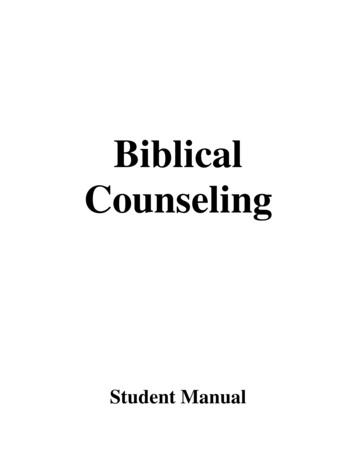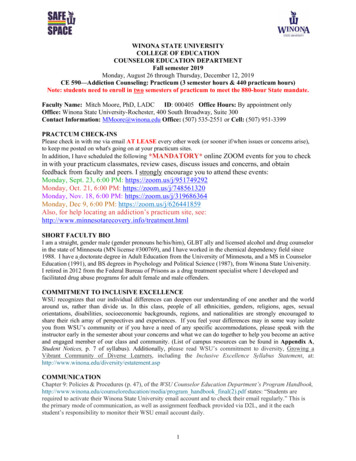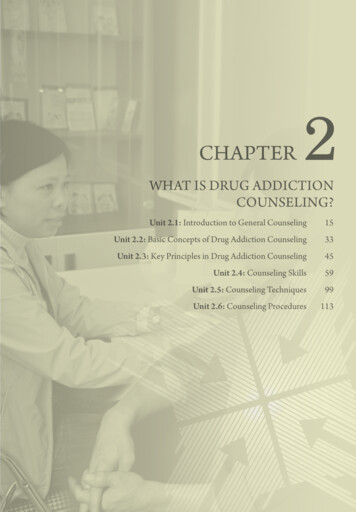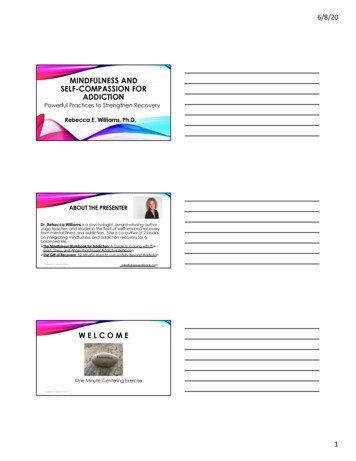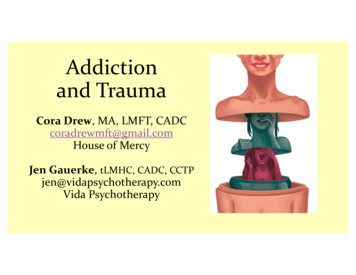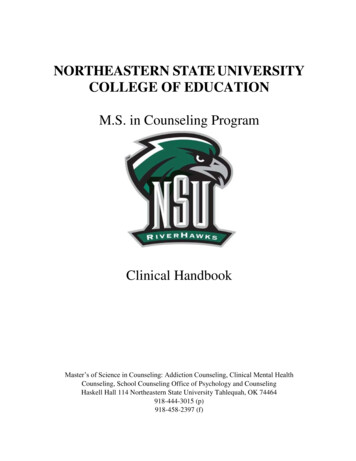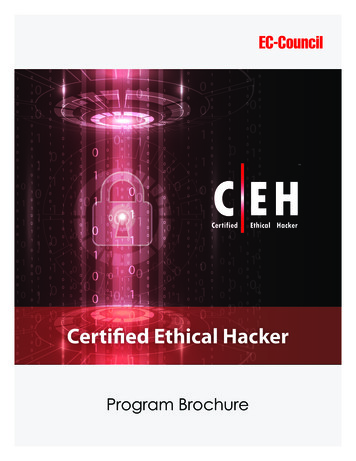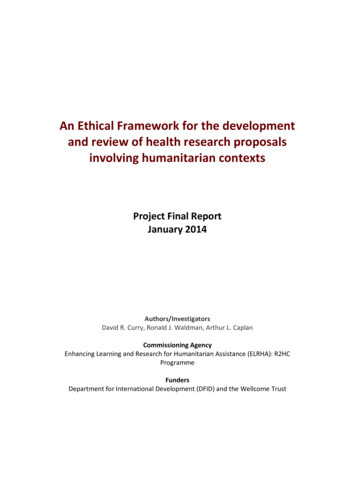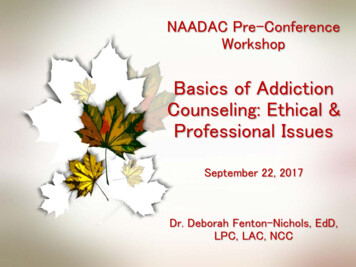
Transcription
NAADAC Pre-ConferenceWorkshopBasics of AddictionCounseling: Ethical &Professional IssuesSeptember 22, 2017Dr. Deborah Fenton-Nichols, EdD,LPC, LAC, NCC
CopyrightThe information presented in this presentation is based on:THE BASICS OFADDICTION COUNSELINGDESK REFERENCEMODULE III: ETHICAL ANDPROFESSIONAL ISSUES INADDICTION COUNSELING,Eleventh Edition October 2017Therefore, these presentation slides are property ofNAADAC and may not be used without NAADAC writtenpermission.
Agenda NAADAC Code of Ethics--Introduction Ethical Decision Making Nine Principles SAMHSA TAP 21 Addiction CounselingCompetencies SAMHSA Tools & Practices to GuideEthical Use of TAC34 Ethics Links and Resources
Workshop Objectives Workshop Overall Objectives Present NAADAC 2016 Code of Ethics & SAMHSACompetencies & Their Relevancy Review Professional & Ethical Behavior Provide Tools for Critical Analysis & EthicalDecision-Making Provide Resources for Further ProfessionalDevelopment
Ethics Aspirational Ethics: What is the best – highestlevel of practice? Mandatory Ethics: What does the law, rule, orethic’s code require of me? Positive Ethics: How can I be da support, help,resource? Principle Ethics: What should I do? Value Ethics: Who am I – what do I believepersonally? Virtue Ethics: Who am I when no one iswatching? Who should I be?
Core Values: Principle/Virtue Autonomy Beneficence Competence Conscientious Refusal Diligence Discretion Fidelity Gratitude Honesty & Candor Justice Loyalty Nonmaleficence Obedience Restitution Self-improvement Self-Interest Stewardship
NAADAC 2016 Code of Ethics Purpose & Function—Standard of Practice,Assist, & Guide Maintain Ethical Professional Practice &Risk Management Highlight Emerging Issues & Areas ofConcern Study Guide for NCC AP’s CredentialingExams Professional Development
NAADAC Member Expectations1. Position of trust & responsibility; Highquality care; Acts in client’s best interests;Assists clients to help themselves.2. Adhere to NAADAC Code of Ethics; High levelof ethical conduct; Perform competently &consistently.3. Read and promise to adhere to the code ofethics; Failure to meet ethical standards risksdisciplinary action/revocation.
2016 Code of Ethics--Principles Principle I: The Counseling Relationship Principle II: Confidentiality & Privileged Communication Principle III: Professional Responsibilities & WorkplaceStandards Principle IV: Working in A Culturally-Diverse World Principle V: Assessment, Evaluation, & Interpretation Principle VI: E-Therapy, E-Supervision, & Social Media Principle VII: Supervision & Consultation Principle VIII: Resolving Ethical Concerns Principle IX: Publication & Communications
SAMHSA Competencies-TIP 21Four Transdisciplinary FoundationsTransdisciplinary Foundation I: UnderstandingAddictionTransdisciplinary Foundation II: TreatmentKnowledgeTransdisciplinary Foundation III: Application toPracticeTransdisciplinary Foundation IV: ProfessionalReadiness
SAMHSA Competencies-TIP 21Eight Practice DimensionsI: Clinical EvaluationScreeningAssessmentII: Treatment PlanningIII: ReferralIV: Service CoordinationImplementing the Treatment PlanConsultingContinuing Assessment & Treatment Planning
SAMHSA Competencies-TIP 21Eight Practice Dimensions--ContinuedV: CounselingIndividual CounselingGroup CounselingCounseling Families, Couples, & SignificantOthersVI: Client, Family, & Community EducationVII: DocumentationVIII: Professional & Ethical Responsibilities
Ethics Links & ResourcesNAADAC, the Association for or-Juveniles-in-theJustice-System/SMA09-4073
Ethical Decision MakingNAADAC Pre-ConferenceWorkshopBasics of Addiction Counseling:Ethical & Professional IssuesSeptember 22, 2017Dr. Deborah Fenton-Nichols,EdD, LPC, LAC, NCC
Comprehensive DecisionMaking Process1. Identify and define the problem.2. Review the NAADAC Code of Ethics todetermine which Principles are applicable.3. Consult with a supervisor or experiencedcolleague.4. Determine if there are any potential legalconcerns, and if consultation with anattorney is warranted.
Comprehensive DecisionMaking Process5. Identify all potential courses of action andtheir potential consequences.6. Decide on a specific course of action.7. Implement the course of action. Documentthe entire situation appropriately.8. Reflect on the outcome of the course ofaction. Make adjustments if needed.
Three Key Attributes Commitment: the desire to do the rightthing, regardless of the cost; Competency: the ability to collect andevaluate information, developalternatives, and foresee potentialconsequences and risks; and Consciousness: the awareness to actmindfully and consistently, applyingmoral convictions to behavior.
Important ElementsBest Decisions:Are ethical and effectiveAccomplish desired outcomesPromote professionalismMeet short-term and long-term goalsRemembers the client is the main concern
Case Example
Case EvaluationWhat is wrongwith this picture?
NAADAC Pre-Conference WorkshopBasics of Addiction Counseling:Ethical & Professional IssuesPrinciple I: TheCounselingRelationshipSeptember 22, 2017Dr. Deborah Fenton-NicholsEdD, LPC, LAC, NCC
Principle I Ethics Base Principle Ethics– Autonomy– Fidelity Virtue Ethics– Loyalty
Informed Consent/Mandatory Disclosure Before services begin– Informed consent process– Orally– In writing (translations if needed)– Signatures of client and provider– Client copy and file copy Reminders of informed consent– After detox– Crisis– Elements arising in session– Cognitive challenges
Informed Consent Elements Names of agency & providers with roles intreatment Provider(s) scope of competence– Education/Training– Qualifications/Credentials– Specialty areas Specifics of services offered Nature/Effectiveness Referral & Termination policies Where, duration, and limits of services
Informed Consent Elements—Continued Privileged & confidential limits/breaches Duty to warn rules Conflicts of interest Access to all relevant ethics codes Parameters of documentation storageand time requirements Client expectations/consequences Social media boundaries/risks
Informed Consent Elements—Continued Cancellation policy/missed appointments Service costs Nonpayment policies and procedures Insurance use/denial Information for filing grievances
Counseling RelationshipServices Right to language/medium of primarylanguage Alternate arrangement – Englishproficiency Check understanding of the client Willing to change/not change
SMART Goals—Treatment Plan SpecificMeasurableAttainableRealisticTimely Collaboratively with client
Clinician Alertness Value conflicts Transference/countertransference Supervision/consultation No romantic or sexual relationships– Once a client—always a client.
Dual (Multiple) Relationships Discussed openly Professional not casual/personal No financial/material gain Will not exploit clients Seek supervision before attendingsocial gatherings. Boundaryextensions Document decision & therapeuticrationale Rules for social media Providers do not “friend” clients.
Responsibilities & Rights Provider to inform client of any changeto role Client has right to refuse service due toprovider role change Provider responsible to manage andmaintain counseling relationship Communicate nature of professionalrelationship Inform client of rights to autonomy
Professional Loyalties Maybe in conflict with client welfare Clearly define the client Communicate role & obligations to allparties prior to informed consent. Advocate for clients Know agency policies Self-referrals, fee splitting, fees, termination Not abandoned or neglected
Documentation Record or file containing all documentsrelated to the client. Complete in timely manner Changes require dates and signatures Meet agency, state & federal rules andregulations Safety and confidentiality maintained Cloud-storage: BBA—Businessassociate agreement
The Counseling RelationshipCase example
Principle II: Confidentiality &Privileged CommunicationNAADAC Pre-Conference WorkshopBasics of Addiction Counseling:Ethical & Professional IssuesSeptember 22, 2017Dr. Deborah Fenton-NicholsEdD, LPC, LAC, NCC
Principle II Ethics Base Principle EthicsBeneficence Virtue EthicsDiscretionLoyalty
Confidentiality The “assurance that informationwill be kept secret, with accesslimited to only appropriatepersons.” General Rule “Do not disclose any informationconcerning a client, to anyone,without their written consent.”
Do Not Confirm or Deny Enrollment In:1Facility Services2Support Groups3Self-Help Groups
Do Not Reveal Session Contents To:1Spouse2Third-Party Payor3Treatment Team Members4CourtsRequires client written consent & only pertinentinformation is to be disclosed.
Privileged Communication“Legal recognition of a private, protectedrelationship where information disclosedbetween the two parties (Provider andclient(s))—with a few exceptions—remainsconfidential and cannot be forcibly disclosedby the legal system” (p. 57-58).
Privacy“The client’s right to be selective aboutwhat information is released and whatinformation is kept confidential” (p. 58).
Nine Exceptions: Confidentiality & Privacy1. Clear &Imminent Danger4. MedicalEmergency7. CrimePremises/Staff2. Suspected Childor ElderAbuse/Neglect5. EthicalGrievance Filed8. Insurance“Need to Know”3. Consultation6. AttorneyConsultation9. WrittenConsent-LegalGuardian
Building Blocks for TrustMaintaining gagementPrivileged Communication
Recognize Importance of rally-appropriateInformed consentServicesTermination & Referral
Federal Confidentiality Act 42 CFR Part 2 Providers: Federally-funded or –assistedprograms Four possible disclosures w/o clientconsent Medical emergencies Research activities Court order Audit & evaluation activities
42 CFR Part 2—Cont. Disclosure cannot be made on anyconsent where: Consent has expired Fails to conform to required elements Known to have been revoked Materially false: known or reasonable diligence Repeat disclosure requires client’sexpress consent.
HIPAA Health Information Portability andAccountability Act of 1996 Privacy rights & protections—healthinformation Use & disclosureAll devices & storage to be secure
Data Safeguards State & federal laws andprofessional ethic codes Virtual private network (VPN) Multi passcodes Encryption Data security Media sanitization
Data Transmission Fax is more secure than email Email requires secure, encryptedserver Clients right to refuse mode oftransmission
Appropriate Client Records Protects provider/agency Malpractice & indictments ofnegligence Protects client Provider & treatment accountability Documents client treatment Records supervision/consultation
Record Recommendations Legible & in written ink (no whiteout) Dates & type of service DAP or SOAP note format Clearly distinguish objective data fromsubjective interpretations.
Record Recommendations Provider signature, date, and credentialsfor each entry Medication dispensing meet federal &state laws Maintain for period stipulated by federalor state law or contract – whichever islongest (7 years)
Case example
References http://www.naadac.org/assets/1959/16ak heymanlayne hipaa and 42 cfr ppt.pdf
Principle III: Professional Responsibilities& Workplace StandardsNAADAC Pre-Conference WorkshopBasics of Addiction Counseling: Ethical & Professional IssuesSeptember 22, 2017Dr. Deborah Fenton-Nichols, EdD, LPC, LAC, NCC
Principle III Ethics Base Principle ethics– Beneficence– Nonmaleficence Virtue ethics– Justice– Loyalty
Definitions Integrity: Being honest, decent,moral, fair, virtuous, truthful,congruent, genuine, principled Discrimination: Unjust & biasedtreatment due to race, ethnicity,age, gender identity, sexualorientation, drugs used & abused,addictive behaviors, mental healthdisorders. Microaggression: Casualdegradation of a marginalizedgroup.
Definitions—Continued Covert racism: Racialdiscrimination disguised and subtle Fraud: Wrongful or criminaldeception for financial or personalgain. Advocacy: Act or process ofsupporting a cause, idea, orproposal
Client Rights RespectEmpathyBest treatment availableQualified & competent providerOwn beliefs, values and attitudes
Definitions Scope of Practice (Boundaries ofCompetence): Gained througheducation, training, skillsdevelopment, & supervisedexperience. Standards of Practice: Industryexpectations and standards Multidisciplinary Care: A team ofprofessionals from a range ofdisciplines collaborating delivery ofcare and outcomes for clients
Definitions—Continued Dual Relationships: Where multipleroles (professional & personal)exist between Provider and client. Impairment: Loss of any normalfunctioning physiologically, socially,psychologically and/or emotionally.
Building Scope of Practice Professional organizationsConferencesWebinarsEducational & specialized trainingSupervision/Consultation
Providers Will Seek supervision, consultation & trainingto increase multicultural knowledge Obtain supervision & consultation fromperson with extensive experience Obtain client written informed consent fornew techniques, tools or treatmentmodalities prior to use
Providers Will Engage in evidence-based, researchdriven activities supported by outcomedata Offer sliding-scale or pro bono services Engage in healthy self-care reducing burnout and aid in the provision of the highestlevel of care
Definitions Transference: Where the client isredirecting feelings to others on tothe Provider. Countertransference: Where theProvider reacts to the client’stransference by directing feelingstoward the client.
Providers Will Continually monitor themselves for issuesneeding to be addressed When impaired, Provider is expected tolimit, suspend, or terminate professionalresponsibilitiesWhen in doubt, seek supervision orconsultation.
Providers Will Correct errors in credentials, education,practice, and products Arrange for an identified colleague orrecords custodian in writing and outlinedin the Provider’s Will in the event:– Provider retires– Is incapacitated– Or dies
Principle IV: Working In ACulturally DiverseWorldNAADACPre-Conference WorkshopBasics of Addiction Counseling:Ethical & Professional IssuesSeptember 22, 2017Dr. Deborah Fenton-NicholsEdD, LPC, LAC, NCC
Culture The sum of attitudes, customs,beliefs, and history thatdistinguishes one group of peoplefrom another. Is transmitted through language,objects, art, ritual and institutionsfrom one generation to the next.
Cultural Diversity & Competency Diversity is cultural variety anddifferences existing in:– An organization, institution,practice, community, nation,world Competency implies Providersfunction with thorough knowledgeof customs and beliefs of anotherculture.
Humility Provider’s willingness to accuratelyassess:– Oneself & one’s limitations– Gaps in knowledge– Openness to new ideas– Contradictory information &advice—without stereotyping orbias
Cultural Humility & Sensitivity “Cultural humility is a life-long practiceof self-reflection and self-critique thatempowers the Provider to activelyengage in interpersonal relationshipsthat are dynamically diverse andmutually respectful” (p. 81). “Cultural sensitivity is the Provider’swillingness to adapt his/her behaviorand communication to be compatiblewith a client’s cultural norms” (p. 81).
Multicultural Development CEUNAADACProfessional conferencesAcademically-rigorous professionalwebsitesTED TalksWebinars & podcastsProfessional literatureCulturally-experiential activities
Multicultural Treatment Match client needs with Providercompetency Appropriate referrals to meet clientneeds Modify behaviors to be culturallyappropriate– Professional distancing– Self-disclosure– Non-erotic touch, hugs– Meeting outside of the office– Accepting gifts– Incorporating traditional spiritual/healing activities
Multicultural Treatment—Cont. Use culturally appropriate assessmentand diagnostic tools. Adjust as needed. Deliver information in a developmentallyand culturally appropriate manner. Translation, interpretation & otherservices as needed Problems are defined and describedthrough cultural lens DSM-5 Cultural Formulation Interview Address potential barriers & obstacles totreatment services.
Professional Responsibilities& Cultural DiversityCase example
Principle V: Assessment,Evaluation & InterpretationNAADAC Pre-Conference WorkshopBasics of Addiction Counseling:Ethical & Professional IssuesSeptember 22, 2017Dr. Deborah Fenton-Nichols,EdD, LPC, LAC, NCC
Assessment Culturally sensitive & bilityAdminister as standardizedSufficient empirical dataIntegrity & Security of assessments“Do No Harm”
Evaluation, Interpretation,& Diagnoses Accurate Culturally sensitive Encompass more than one instrumentand clinical interview Proper Releases of Information Cultural Context Aware of and mitigate Provider biases Client’s mental capacity Sharing diagnosis with client
Forensic Evaluations Objective findings Accurate report of findings Based on professional knowledge,research, expertise, and supported bydata. Clients informed in writing– Nature– Purpose– Who will see the results– Not therapy Court ordered evaluation can be donewithout client consent.
Principle VI:e-Therapy,e-Supervision& Social MediaNAADAC Pre-Conference WorkshopBasics of Addiction Counseling: Ethical& Professional IssuesSeptember 22, 2017Dr. Deborah Fenton-Nichols,EdD, LPC, LAC, NCC
e-Therapy e-Therapy: telemental health,telepsychology, telepsychiatry, &telebehavioral health Use of technology (online, telephone) toprovide services. Synchronous delivery: live real time, faceto face Asynchronous delivery: emails, distantsite, not live in the moment
e-Therapy Text messaging—synchronous orasynchronous Mobile devices—computers, tablets, mobilephones & smart phones “app”—application or software run ontechnology devices
Technology-Assisted Care (TAC)1Individuals2Couples3Families4Groups
Evidence-Based TAC Benefits Increased access of care Reduces travel time and costs Improves satisfaction with SUD, ABD, &MH system Enables continuity of care
Evidence-Based TAC Benefits Reduces delays initiating services Serves diverse group with similarpresenting concerns Greater alignment with telehealth Reducing stigma
TAC Delivery Options Telephone-based services Email-based services Chat-based services Video-based services Social Network-based services Self-directed, technology-basedtherapeutic tools
TAC Providers Ensure electronic means are withinregulatory standards Are located, certified/credentialed in theclient’s state of residence Will document all relevant laws ®ulations Will use encryption software & VPNservers
TAC Providers Provide a separate e-therapy/technologyinformed consent Communicate risks & benefits to client Maintain a secured backup system with itsown encryption security. Screen potential clients forappropriateness.
Technological Competencies Knowledge Skills AttitudesSAMHSA (2015). TIP 60: Using Technology-Based Therapeutic Toolsin Behavioral Health Services. Rockville, MD: Center for SubstanceAbuse Treatment. p. 105.Clinical supervision/e-supervision require adistinct set of competencies.
TAC Providers Will ensure client ID Establish codes for continued identification Establish emergency services in clientarea Discuss confidentiality Use cultural sensitivity Discuss safety & location of anydocumentation
Social Media Professional from Private Communicate boundaries in detail Use with active and former clients Discuss risks Viewing client’s social media pages
Electronic Health Records (EHR)EHRs are intended to improve:RecordkeepingOutcomeReportingPatient TransitionsAcross ProvidersQuality of ClientCare
EHR Benefits Access to client records remotely Alerts regarding lab results Alters regarding medication errors Reminders specific to preventative care Provide care meeting clinical guidelines Facilitate direct communication betweenProvider and Client Enhance overall patient care
Evaluation & e-TherapyCase example
Do you haveany questions?
Principle VII: Supervision& ConsultationDr. Deborah Fenton-Nichols,EdD, LPC, LAC, NCC
Clinical Supervision Function– Monitoring and training– Job satisfaction– Treatment outcomes– Counselor wellness Relationship and Intervention– Observation, evaluation, & feedback– Instruction, modeling, & mutual problemsolving– Competent manner, ethical standards,legal prescriptions, & professional practices
Clinical Supervisor Roles TeacherSounding boardMentorEvaluatorProblem-solverEmpower-er
The Relationship Professional, formal, hierarchical, &evaluative Extends over a specified length oftime Enhances professional growth,development, and functioning ofthe junior member Monitors the quality of servicesprovided Ongoing gatekeeping responsibility
Clinical Supervision Goals Promote professional & ethicalgrowth and development of juniormember. Protect the welfare of clients. Monitor performance of the juniormember. Empower the junior member to“self-supervise”.
Cognitive & Behavioral Change Provided– Comprehensive plan of action– Management support– Effective mentoring & leadership– Invested for a sufficient period ofeffort
Clinical Supervision &Addiction Counseling Parallel Process– Strong supervisory Strongclinical relationships– Supervisory relationship parallelsclinical relationship– Supervisee’s interactions withsupervisors parallel supervisee’sinteractions with clients
Clinical Supervisors Are culturally sensitiveClarify relationship boundariesActively listenDo not stereotype supervisees.Recognize confidence and powerdifferentials Self-aware of own identity & biases Teach to supervisee’s strengths Create a collaborative environment
Clinical Supervisors Are gatekeepers of addiction &mental health counseling profession Uphold highest standards for clinicalservice delivery Acts as a role model Has awareness and responds toethical concerns—timely & prudentmanner Teach principles of ethical decisionmaking
Five Primary Ethical Issues Vicarious liability: liability to thesupervisor due to supervisee’sactions or lack of action Dual relationships and boundarymanagement Informed consent Confidentiality & appropriatereleases Duty to warn
Supervisee’s 3 Levels Include Overview of StageSelf-Other AwarenessMotivationAutonomy
Level 1 Limited training or experienceHigh levels of self-focusLittle self-evaluationAnxiety related to supervisor evaluationConcern: “Doing it right”Motivation & anxiety are focused onacquisition of skillsWants to know the “correct” approachVery dependent upon supervisorRequires high levels of structureNeed positive reinforcementUnable to tolerate direct confrontation
Level 2 Transitioning from high levels of dependence &imitative forms Beginning to respond to highly structuredsupervisory practices Increased ability to focus on client & exhibitempathy Still struggles to balance focus on self & client May become confused & enmeshed with client Fluctuates high levels of confidence, feelings ofincompetence, and confusion Vacillates between autonomy & dependence(resistance)
Level 3 Developing personal approach to counselingUnderstands & utilizes “self” in therapyGreater level of self-awarenessAbility to focused on client while attending topersonal reactions & responses to clientMotivation is consistent as confidenceincreasesMay still exhibit some self-doubt but lessimpactfulSolid belief in own judgment and skillsSupervision becomes more like consultation
Level 3i: Integrated Supervisee has reached Level 3 across multipledomains Personal style of counseling has emerged Demonstrates high levels of awarenessregarding personal competency
Clinical Supervision Conducted on a regular basis Face to face or using electronicformats Supervision Contract Individual or group Group 6 supervisees/ 4 preferred Administrative supervisor providingclinical supervision discusses dualrelationship keeping roles separate. Peer supervision: nonhierarchical
Supervisees Provide clients with supervisoryinformation on the mandatorydisclosure statement Discuss requirements/limits ofconfidentiality Disclose frequency and modality
Supervisors Do not counsel friends or family. Do not have intimate relationshipswith supervisees. Do not engage in sexualharassment activities against asupervisee. Is knowledgeable of technologyrequirements and competenciesnecessary for supervision whenconducting e-supervision.SAMHSA (2015). TIP 60: Using Technology-BasedTherapeutic Tools in Behavioral Health Services.Rockville, MD: Center for Substance Abuse Treatment.p. 132
Supervision Is Sought Rural area dual relationships Concerns regarding viability of thecounseling relationship Discuss termination/referral To help determine area ofcompetency Encouraged for all Providers toprovide ongoing feedback regardingknowledge, skills, & areas ofcompetence And documented as well astrainings and credentials
Administrative Supervision Assessing client, clinician, & staff needs Scheduling & planningagency/clinician/staff workflow, and humanresources needs Tracking activities Applying for grants & other sources offunding, and monitoring fundingcompliance Scheduling clinician & staff vacations andother time off Managing the office/agency
Consultation Collaborative problem-solving process Clinician engages a subject-matter expert Advancing appropriate, ethical, & legalcare to a specific client Act or not act on received advice Consultation is between two peers in nonhierarchical relationship
SupervisionCase example
Principle VIII: ResolvingEthical ConcernsNAADAC Pre-ConferenceWorkshopBasics of Addiction Counseling:Ethical & Professional IssuesSeptember 22, 2017Dr. Deborah Fenton-NicholsEdD, LPC, LAC, NCC
NAADAC’S 10-Step EthicalDecision Making Model:1. Identify ethical dilemma and/or legalissues (nature & dimensions)2. Apply the NAADAC Code of Ethics &applicable laws.3. Consult with clinical supervisor,consultant-expert, or experiencedcolleague. Determine potential legalconcerns (consult with attorney)4. Generate list of all potential courses ofaction & solutions.5. Evaluate each option for potentialconsequences (beneficial & detrimental)
NAADAC’S 10-Step EthicalDecision Making Model:6. Implement the chosen course(s) ofaction.7. Document the entire situation, includingthis ethical decision-making activity8. Analyze the implementation of the chosencourse(s) of action.9. Reflect on the outcome(s) of the courseof action. Make adjustment if needed.10.Re-assess if implementation was notsuccessful, and begin decision-makingprocess again.
Ethical Decision-Making Use NAADAC 10-Step Process– For questionable & concerningsituations & problems– To demonstrate intent to act ethically,legally, & professionally responsiblethrough documentation & consistentuse.– Earlier in career provides moreprotection from future legal & ethicalclaims– Is intentional risk managementcornerstone & underscores desire forexcellent clinical care by protecting theclient(s), Provider(s), agency,community, & profession
Ethical Decision-Making Case example
Principle IX:Publication &CommunicationNAADAC Pre-Conference WorkshopBasics of Addiction Counseling: Ethical &Professional IssuesSeptember 22, 2017Dr. Deborah Fenton-Nichols,EdD, LPC, LAC, NCC
Increasing s to knowledge base
Findings & Facts Obligation to present oral orwritten findings/facts in an ethical& professional manner Providers, researchers, scientists,& organizations have research &publication obligations &responsibilities– Planning, designing, conducting, &reporting findings Published consistent with relevantethical principles, laws, institutionalregulations, & pertinent scientificstandards
Credit for Material Published Addiction-related materials towhom it is due Providers do not take credit formaterial they did not participate indeveloping. Providers do not present ideas,formulations, practices and/orresearch of others. Ethical providers always giveappropriate credit to theoriginators in written & spokencommunications
Credit for Material Published It is unethical to deny credit tothose who provide assistance.– Editing, typing, background research,joint authorship Authors positions determined bysize of contribution in descendingorder. Addiction professionals must neveruse any copyrighted materialwithout permission for the author.– Materials can never be reproduced forprofit, regardless of the educationalpurpose.
Basics of Addiction Counseling: Ethical & Professional Issues September 22, 2017 . SAMHSA TAP 21 Addiction Counseling Competencies SAMHSA Tools & Practices to Guide Ethical Use of TAC. 34 . SAMHSA Competencies-TIP 21. Eight Practice Dimensions. I: Clinical Evaluation. Screening . Assessment.
